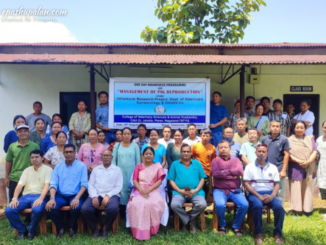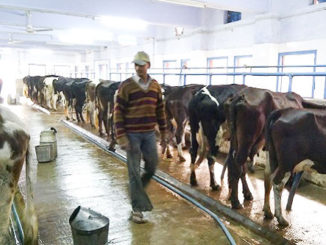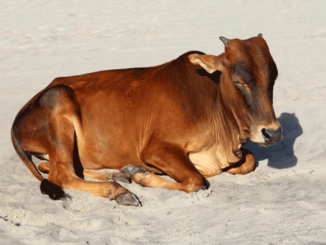
World Wildlife Week-2024 Celebration
College of Veterinary Sciences and Animal Husbandry, CAU, Jalukie and Divisional Forest Office, Jalukie, Govt. of Nagaland jointly organized the “World Wildlife Week-2024” on 2nd and 3rd of Oct’ 2024. >>>







College of Veterinary Sciences and Animal Husbandry, CAU, Jalukie and Divisional Forest Office, Jalukie, Govt. of Nagaland jointly organized the “World Wildlife Week-2024” on 2nd and 3rd of Oct’ 2024. >>>

Department of Veterinary Medicine, College of Veterinary Sciences and Animal Husbandry, Jalukie, Nagaland organized an awareness programme on “Emerging diseases of Livestock and Poultry in Nagaland” for Livestock and Poultry Farmers in Peren district of Nagaland” >>>

A one day awareness programme on Management of Pig Reproduction is organized by the Department of VGO, College of Veterinary Sciences and Animal Husbandry, Jalukie, Nagaland” for pig breeders. >>>

Dr. Kailash Uniyal, President of the Uttarakhand Veterinary Council, held a formal meeting today with Shri S.P. Baghel, Hon’ble Minister of State Government of India, and Dr. Umesh Chandra Sharma, President VCI. >>>

Rabbits belong to the order of mammals called Lagomorpha, which includes 40 or so species of rabbits, hares and Pikas. Fossil records suggest that Lagomorpha evolved in Asia at least 40 million years ago, during the Eocene period. >>>

Edible vaccines mark a modern approach of oral immunization. The manufacturing process of a plant derived vaccine foremost involves the selection of the gene of interest. The target gene >>>

Muscle mass maintenance requires a balance between muscle protein synthesis and muscle protein breakdown and gain in muscle can occur only when the synthesis exceeds the breakdown. >>>

Personal development is a lifelong process and it enhances confidence and self-worth. Self-knowledge is the first step in personal development. It is crucial that you understand yourself; in order >>>

Ruminants are one of the most successful groups of herbivorous mammals on the planet, with around 200 species represented by approximately 75 million wild and 3.5 billion domesticated individuals worldwide. Humans domesticated these animals in the Neolithic era (Ajmone-Marsan et al., 2010) and have been farming them ever since for the production and consumption of animal protein in the form of meat and milk. >>>

Frequency of tick vectors, tick-borne haemoprotozoan diseases (TBDs) are most common in tropical and subtropical locations around the world. Babesiosis, Hepatiozoonosis, and Trypanosomia >>>



College of Veterinary Sciences and Animal Husbandry, CAU, Jalukie and Divisional Forest Office, Jalukie, Govt. of Nagaland jointly organized the “World Wildlife Week-2024” on 2nd and 3rd of Oct’ 2024. >>>

In today’s world, every pet owner wants the best possible care for their furry friend. Advances in veterinary medicine have led to improved diagnostic tools, and one of the most significant game changers is CT scan. A CT scan (computed tomography) is a non-invasive diagnostic tool that uses X-rays and computer technology to produce detailed cross-sectional images of the body. In veterinary medicine, CT scans are used to visualise internal structures, diagnose disease, and guide treatment plans >>>

Department of Veterinary Medicine, College of Veterinary Sciences and Animal Husbandry, Jalukie, Nagaland organized an awareness programme on “Emerging diseases of Livestock and Poultry in Nagaland” for Livestock and Poultry Farmers in Peren district of Nagaland” >>>

A one day awareness programme on Management of Pig Reproduction is organized by the Department of VGO, College of Veterinary Sciences and Animal Husbandry, Jalukie, Nagaland” for pig breeders. >>>

Dr. Kailash Uniyal, President of the Uttarakhand Veterinary Council, held a formal meeting today with Shri S.P. Baghel, Hon’ble Minister of State Government of India, and Dr. Umesh Chandra Sharma, President VCI. >>>

Stem cells are very important in veterinary medicine for various reasons. Numerous stem cell treatments are now being administered to animal patients; some of these have proven beneficial in the market, such as mesenchymal stem cell >>>

Mastitis is one of the most important economical diseases of dairy cattle. Generally, the clinical form of mastitis divided into mild, moderate or severe. >>>

Canine babesiosis is a serious disease among tick-borne haemoprotozoan diseases, globally. Canine babesiosis can range from chronic or subclinical to peracute and fatal, depending on the virulence of the species and the susceptibility of the host. >>>

Breeding Seasons Dairy goats are usually seasonal breeders. Most breeding occurs in late summer through >>>

Wildlife traditionally refers to undomesticated animal species, but has come to include all organisms that grow or live wild in an area without being introduced by humans. >>>

The total Pigs in the country is 9.06 Million in the current Census 2019, declined by 12.03% over the previous Census (2012). About 1.7% of the total livestock is contributed by pigs. >>>

Basic requirements of horses are shelter, feed, water, grooming, waste removal and exercise that will be discussed in this article. >>>

In India, raising cattle has long been a traditional source of income and is strongly associated with the agricultural sector. According to the 20th Livestock Census 2019, India has 192.41 million cattle, among which 142.11 million i.e. 73.83%, are indigenous >>>

Rabbits belong to the order of mammals called Lagomorpha, which includes 40 or so species of rabbits, hares and Pikas. Fossil records suggest that Lagomorpha evolved in Asia at least 40 million years ago, during the Eocene period. >>>

This is the story of adapted village under Farmers FIRST project “Kathura” (Khelgao) of district Sonipat (Haryana) >>>

India is considered as one of the fastest growing economies of the world. Animal Husbandry sector contributes more than 25% to India’s agriculture GDP and adds directly more than 4% >>>

A 7 yrs old Bullock was presented with protruded tongue, blood tinged excessive salivation having deep lacerated wound starting from the body to apex of tongue. >>>

Infectious diseases in animals pose a serious and continuing threat to food security, food safety, national economies, biodiversity and the rural environment. An infectious animal disease can spread >>>

In some cases, Viral diseases can cause major social, economic, and environmental impact, as well as posing a risk to human health. Due to the effects of global change, many livestock-related dangers >>>

Animal welfare is undertaking micro animal husbandry practices on the livestock at the farm, and is directly related to health, reproduction & production of animals under comfortable as well as animal friendly environment. Animal welfare practices have a positive effect on production and reproduction performance of dairy animals. >>>

Winter is the deadly season of many stray animals as well as farm animals. Some of reports in Delhi said winter causes death of stray dogs. Management of winter stress to the animals is very much necessary for many small scale farmers. >>>

Dairy farming is the use of information and technology based farm management system to measure physiological, behavioral and production indicators of individual animals to improve management strategies, profitability >>>

Modern agriculture witnessed the green revolution through the use of chemical fertilizers, pesticides and hybrid seeds of different cereals, pulses etc. in order to have sufficient food for our ever-increasing population. We are number one in the world in milk production, which is achieved through importation of exotic animals, crossbreeding with indigenous cows and buffaloes. >>>

Major Reproductive Problems in Dairy Animals Repeat Breeding When a cow has failed to conceive after three or more services, has a typical estrus cycle length, no abnormalities in the vaginal >>>

Vaccination in dairy animals is an important and cost-effective way of preventing the spread of infectious diseases in animals. It has greatly aided in the reduction of animal mortality >>>

Uterine prolapse is occasionally observed in pigs up to several days after parturition or during farrowing. Excessive abdominal pressure or straining due to mal-position of fetus >>>

Most common Uterine complications is Pyometra which is characterized by the accumulation of purulent or muco-purulent material within the uterine lumen along with distension of the uterus >>>























